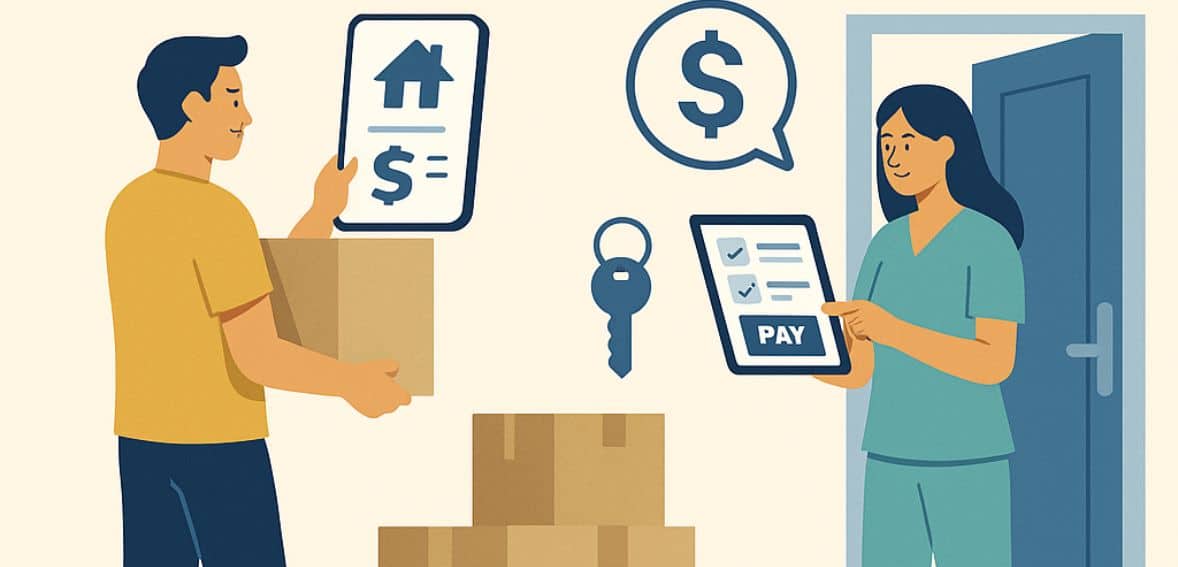
By Grayson knights July 23, 2025
Remember the days of stacks of paperwork, waiting for checks, and endless delays during move-in/move-out? Those times are fading fast. Tenants were expected to manage physical checks, navigate unclear charges, and wait through extended processing times. In the meantime, property managers had to manage ledgers, approvals, and inaccurate bookkeeping while adhering to strict deadlines.
This landscape is changing today. These transitions are being made much easier by the integration of automated systems, mobile-accessible platforms, and digital payment tools. Tenants and property managers now approach the financial aspects of move-ins and move-outs with more ease and confidence thanks to quicker processing, better accuracy, and increased transparency.
From Paper Checks to Digital Payments: Why It Matters

Move-in and move-out processes used to be primarily based on in-person cash or check exchanges and tons of paperwork. Fear of misplaced documents and postponed ledger updates plagued both parties. Managers used to spend hours chasing checks, balancing ledgers by hand, and following up on missed payments—often to the point of burnout.
Tenants faced late rental charges or waited weeks—or longer—for deposit refunds. Today’s digital payments, on the other hand, relieve this burden from human shoulders by offering automated workflows, audit trails, and instant confirmations. While residents benefit from faster access to digital receipts and account balance transparency, property owners save money on processing expenses and minimize human error.
Automating Move‑In Payments: Deposit, Fees, and First Month Rent
Current property platforms allow tenants to pay the first month’s dues, administration fees, prorated rent, and deposits online at the beginning of the rental agreement. By integrating online invoicing, ID checks, and document verification into a single portal, digital lease signing and payment module integration removes delays.
This integration establishes a solid financial baseline for both parties and expedites move-ins. Property managers can view funds posted instantly, with confirmations that sync into accounting systems, and tenants can pay using ACH, credit or debit cards, mobile wallets, or recurring schedules. This leads to a moment of clarity and less administrative chaos on move-in day.
Streamlining Move‑Out Transactions: Fees, Inspections, and Refunds
Dedications for damages, cleaning fees, prorated rent, or unused utilities are just a few of the new potential conflicts that move-outs can bring. In the past, disagreements have arisen over policy ambiguity, photographer condition logs, or timing. These days, condition reports linked to tenant accounts and time-stamped photos are made possible by inspection apps.
Digital platforms compute refunds automatically at the same time, deducting the relevant fees and initiating digital refund credits or direct deposit. Tenants are promptly provided with clear breakdowns. Instead of having to deal with recurring refund audits, managers close the ledger with clarity and confidence.
Tenant Portals and Mobile Apps: Convenience Meets Clarity

Direct tenant access to portals or mobile apps significantly enhances the overall tenant experience, making digital move-in/move-out payments more transparent and user-friendly. At their convenience, residents can view charges, customize payment methods, and monitor history using these interfaces. Mutual understanding exists because everyone can see the same information, such as deposit balances, impending charges, or inspection records.
Tenants are less likely to misunderstand when payments are made on time or transactions are missed when they receive digital receipts instantly. Long-term satisfaction is supported by a more seamless onboarding and offboarding process.
Automation and Integration: Seamless Accounting and Transparency
Healthy financial operations depend on integration. Errors are decreased and manual entry is eliminated by systems that connect payment portals to accounting programs like QuickBooks or integrated rent collection software. Property managers have faster reconciliation and more accurate data when deposits, bills, refunds, and late fees all come in automatically.
Reporting dashboards offer visibility into move‑in/out cash flows—deposit held, deposit returned, outstanding charges—with minimal intervention. Managers can concentrate on tenant relationships rather than administrative catch-up thanks to this efficiency.
Efficiency Gains and Cost Savings

There are measurable savings when moving from manual processes and paper checks to digital workflows. According to research, processing paper checks can cost anywhere from $3 to $10 per transaction, which for large portfolios can add up to tens of thousands of dollars annually.
Saving money and staff time is achieved by doing away with manual tracking, printed ledgers, and mailing expenses. At the same time, turnover cycles are shortened, openings are filled more quickly, and trust is increased through financial transparency.
Enhanced Security, Documentation, and Compliance
Secure gateways, encryption, and compliance with PCI-DSS standards are prioritized by digital and mobile payment platforms; every transaction is monitored, time -stamped, and recorded. In addition to avoiding mistakes, this guards against disagreements, unapproved charges, and misplaced paperwork.
Because digital records are simpler to share, consult, and rely on in the event of a dispute, this benefits managers and landlords by increasing tenant trust and improving audit readiness. Platforms for tenant onboarding also streamline legal paperwork and verification while maintaining privacy and transparency.
Overcoming Common Challenges and Adoption Obstacles
There are benefits to digital payment systems, but there are also learning curves. Offering hybrid approaches and educating tenants about the advantages of speed and convenience are necessary to address the preference of certain tenants for cash or paper checks. There may be privacy, fee issues, or occasional ACH disputes, especially if platforms include small processing charges or delays in clearing.
Transparent communication is essential. You can allay worries by providing options such as ACH over card fees, sharing fee structures up front, or connecting users to credit-building rent reporting. Wider adoption is ensured by resident education through staff support or FAQ pages.
Choosing the Right Tools: What to Look For

Platforms that provide online lease signing, integrated payment modules, mobile access, secure encryption, smooth accounting integration, recurring or prorated payment capabilities, and tenant notifications are what you want when choosing a digital solution.
These features are now native or available as add-ons for popular property management platforms like Buildium, AppFolio, Rent Manager, or Re-Leased. The best solutions eliminate redundant systems across administrative, financial, and legal touchpoints and streamline the tenant experience from the initial payment to the last refund.
The Role of Smart Notifications in Payment Confidence

In a world where transactions can feel impersonal and timelines blur, clarity through communication becomes critical. This is why digital move-in and move-out payments heavily rely on smart notifications, such as emails, push alerts, or texts. The typical guesswork is replaced with a sense of assurance when a tenant receives an instant ping confirming receipt of their security deposit.
This also applies to updates following inspections or reminders before rent due dates. These touchpoints strengthen trust in addition to avoiding late payments and misunderstandings. By automating these alerts, property managers can reduce last-minute emergencies and phone calls.
These messages’ format, timing, and tone are important. The entire tone of a tenant’s experience can be changed with professional, personable updates that sound human rather than robotic. Even a simple message like “Your refund has been initiated, and here’s what to expect” can make a big difference. More than speed, digital payments are about confidence, and notifications are how that confidence manifests.
The Psychology Behind Digital Payments and Stress Reduction
One of the most stressful things people can go through is moving, and a lot of that stress is caused by financial uncertainty. The deposit is due when? Will the most recent rent payment be appropriately adjusted? Will my deposit ever be seen again? Digital tools ease the emotional burden by simplifying payments into organized, trackable systems.
Tenants can now view balances in real time, eliminating the need to chase receipts or hope the math is correct. Property managers no longer rely on hand-written logs or hope the post office delivers that final check. Beyond ease of use, that mental calm fosters emotional clarity amid upheaval.
Tenants can concentrate on unpacking and making a fresh start now that their money is out of the cloud. And landlords can spend more time building good relationships than solving accounting puzzles. When both sides feel calm and informed, the whole moving process becomes something that resembles progress, not pain.
Building Long-Term Loyalty Through Smooth Transitions
Move-in and move-out days are crucial times for fostering brand loyalty, despite the fact that many landlords view them as transactional endpoints. Tenants are much more likely to recommend the property, return in the future, or write a positive review if they have a seamless, digital-first experience where payments are made accurately, communications are prompt, and refunds are handled openly.
For property managers overseeing portfolios across competitive markets, this goodwill becomes even more crucial. Digital payments are now expected rather than a novelty. These tools serve as the foundation for enduring relationships when used carefully during stressful times, such as moving.
The way a tenant feels about their departure affects your brand, even if they are leaving. Did they receive fair treatment? Was their reimbursement processed quickly? Were fees properly explained? With digital tools, you have a better chance of ensuring those answers are “yes,” and these last steps often shape the entire experience. Being easy to work with when it counts most is what fosters loyalty in a service-based sector like real estate, not just cheap rent.
Measuring Success: Metrics That Matter
Managers monitor metrics such as the speed at which move-out deposits are returned, the reduction in manual processing time, the rate of ledger errors, and tenant satisfaction ratings to verify efficacy. Self-service portal users report greater satisfaction and longer retention rates. Automated systems reduce operational costs per move, increase unit turnover, and reduce disputes for managers. This information enhances strategy for upcoming transitions and helps to improve policies, such as automatically triggered prorations or inspection protocols.
Conclusion: Move Transitions That Respect Time and Trust
Tenant and property manager transition days shouldn’t be characterized by misunderstandings and hold ups. Managers establish clarity, consistency, and goodwill by adopting digital solutions for move-in and move-out payments, which cover lease collection, inspection, refunds, and documentation. When tenants are able to transact at their own pace and get real-time updates, they feel valued.
Managers cut down on errors and save hours. Financial openness speeds up occupancy and lowers disputes. Both parties benefit when administrative friction is eliminated by technology. Instead of being stressful, move-in and move-out can be positive transitional times. Modern property managers who streamline payments today are the ones creating stronger communities tomorrow in an era where convenience is expected.